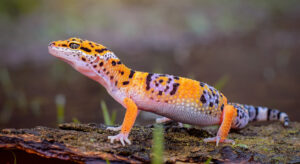Leopard geckos are among the most popular exotic pets, admired for their unique look, low-maintenance care, and gentle nature. But for many pet owners, one question often arises: Do leopard geckos get lonely?
As we dive deeper into the world of reptiles, it’s essential to understand their natural behavior and needs. Many people mistakenly believe that, like cats and dogs, these creatures need companions to thrive. But is that really true?
In this article, we will explore whether leopard geckos feel loneliness, what their social needs really are, and how you can ensure your pet’s well-being—whether they’re solo or in a group. If you’re curious about your leopard gecko’s happiness or worried about their behavior, keep reading! We’ve got all the answers, backed by expert insights and practical advice for every gecko lover.
Understanding Leopard Gecko Behavior

What Are Leopard Geckos?
Before we can understand whether leopard geckos feel lonely, it’s important to know a little more about them. Leopard geckos (Eublepharis macularius) are a species of nocturnal, ground-dwelling lizards native to the deserts of Asia, primarily found in countries like Afghanistan, Pakistan, and India.
They have a distinctive appearance, featuring vibrant yellow and black spots, and are relatively small compared to other reptiles, growing to about 7–10 inches long.
Unlike other geckos that have sticky pads on their feet, leopard geckos have distinct claws, which make them more suited to life on the ground. Their nocturnal nature means they are more active at night, hunting for insects like crickets and mealworms. They’re also known for being hardy and easy to care for, which is why they’ve become a favorite for reptile enthusiasts, especially beginners.
Are Leopard Geckos Social Animals?
Leopard geckos are solitary by nature. In the wild, they lead independent lives, living alone except for the occasional mating season. They are territorial creatures and do not thrive in the presence of other leopard geckos unless they’re a male and female pairing for breeding purposes.
In fact, most leopard geckos prefer to live alone, establishing their own territory and avoiding interaction with other geckos unless absolutely necessary.
Their solitary nature doesn’t mean they lack social behaviors altogether. Leopard geckos do interact with each other when it comes to mating, and they can show behaviors like basking in the same space during the day if they are comfortable in each other’s presence. However, these interactions are typically brief and serve a functional purpose rather than being an indicator of loneliness.
Key Signs of Loneliness in Reptiles
Loneliness, in the way we perceive it with mammals, might not be a concept that applies to reptiles. However, like all animals, leopard geckos can experience stress, which may appear similar to what we think of as loneliness. If your gecko is feeling stressed, you might notice behaviors such as:
- Lethargy: Your gecko might become inactive, hiding more than usual, and not showing interest in food.
- Reduced Appetite: A gecko that’s feeling stressed or unwell may stop eating.
- Excessive Hiding: While geckos love hiding spots, excessive hiding can be a sign of distress or discomfort.
- Aggression: If you’ve added another gecko to the habitat, aggression might occur due to territorial instincts, which could be interpreted as the gecko feeling “unsettled” rather than lonely.
These behaviors might suggest an environmental issue or other stressors, but they do not typically indicate loneliness in the way humans might understand it.
Do Leopard Geckos Get Lonely?
The Truth About Leopard Gecko Loneliness
The idea of loneliness in reptiles, particularly leopard geckos, is somewhat misleading. While leopard geckos are not as social as some mammals or birds, they don’t necessarily suffer from loneliness. In fact, most geckos are quite content being solitary.
Unlike species like parrots, which are highly social and need companionship to stay mentally healthy, leopard geckos are perfectly happy living alone. They don’t require the companionship of another gecko to feel secure or content.
Their behavior revolves more around territory and ensuring that they have enough space, food, and warmth. Therefore, it’s unnecessary—and potentially harmful—to house multiple geckos together unless you’re an experienced breeder or have a specific need.
Are Leopard Geckos Happy Alone?
Yes, leopard geckos are generally happier alone. They’re solitary by nature and enjoy having their own space. In the wild, they are solitary hunters, seeking out their own food and retreating to their burrows or hiding spots for rest. When kept in captivity, they don’t need constant interaction or the presence of another gecko.
As long as they have a suitable environment, leopard geckos are content living independently. They thrive in tanks that mimic their natural habitat, with proper heating, lighting, and hiding spots. For owners who are concerned about their gecko’s happiness, the key is providing an enriching environment that keeps them mentally stimulated rather than relying on the presence of another gecko.
The Risks of Keeping Multiple Leopard Geckos Together
While the idea of providing a companion for your gecko may seem like a good one, it can be risky. Leopard geckos are territorial and can become aggressive if kept together. Male geckos are particularly known for territorial behavior, and even females can show aggression toward one another.
In a shared tank, the presence of multiple geckos can lead to:
- Fighting: Dominant geckos may bully others, causing stress and possible injuries.
- Stress: The competition for food, space, and territory can overwhelm a gecko, making them feel stressed.
- Health Issues: The constant stress from fighting or competing can lead to illness or malnutrition, which is why it’s typically best to keep geckos individually unless you’re a professional.
If you choose to house more than one gecko, it’s crucial to provide a large enough tank with plenty of hiding spots to minimize aggression.
What to Do if You’re Concerned About Your Leopard Gecko’s Well-being

Creating a Stimulating Environment
Even though leopard geckos are solitary creatures, they still need an enriched environment to stay active and healthy. Boredom can lead to stress and lethargy, so it’s essential to create a stimulating habitat for your pet. Here are some ways to keep your gecko happy:
- Hiding Spots: Provide various hiding spaces where your gecko can retreat when it feels the need. This mimics their natural desire for privacy.
- Climbing Areas: Even though leopard geckos are primarily ground-dwelling, adding branches or rocks for climbing can add stimulation and exercise to their environment.
- Varied Substrate: Use a variety of substrates, such as reptile carpet, paper towels, or tile, to allow your gecko to explore different textures.
- Feeding Variety: Offer a variety of insects, such as crickets, mealworms, and waxworms, to keep your gecko engaged during feeding time.
Proper Diet and Care
A balanced diet is crucial to keeping your leopard gecko healthy. Geckos are insectivores, which means their diet consists mainly of insects like crickets, mealworms, and roaches. Providing variety in their diet will keep them interested and satisfied. Ensure that the insects you provide are properly gut-loaded (fed nutritious food) and dusted with calcium and vitamin D3 to promote bone health.
Understanding Leopard Gecko Sleep Patterns
Leopard geckos are nocturnal, which means they’re most active during the night. It’s important to adjust your expectations about their activity levels during the day. Leopard geckos spend a significant amount of time sleeping and resting, and this is perfectly normal. They need a proper day-night cycle to maintain their health, with around 12 hours of light and 12 hours of darkness.
When to Consider Getting a Companion for Your Leopard Gecko
Signs That Your Gecko May Need a Companion
While most leopard geckos are content alone, there are a few rare cases where your gecko may seem to benefit from companionship. However, it’s important to assess their behavior first:
- Increased Restlessness: If your gecko is pacing the tank or showing signs of agitation, it may be stressed, not lonely.
- Excessive Hiding: If your gecko is hiding for long periods, it could indicate stress or discomfort, possibly caused by environmental factors.
- Lack of Appetite: Stress can lead to a decrease in appetite. If your gecko is no longer eating, this could be a sign of something wrong with their environment or mental state.
If you see any of these signs, it’s important to assess their habitat, diet, and general care before considering another gecko.
How to Safely Introduce a Second Leopard Gecko
If, after all considerations, you decide to introduce a second leopard gecko, it’s essential to do so carefully. The introduction process should be gradual:
- Quarantine the New Gecko: Keep the new gecko in a separate tank for at least two weeks to ensure it’s healthy and free from parasites.
- Observe for Aggression: When introducing the geckos, watch for any signs of aggression or stress. If aggression occurs, separate them immediately.
Alternatives to Companionship
If you’re worried about your gecko’s well-being but don’t want to risk housing two geckos together, there are plenty of alternatives:
- Interactive Time: Spend more time handling your gecko gently, allowing them to explore outside their tank.
- Enrichment: Continue to enhance their habitat with stimulating features like new hiding places, climbing structures, or even a small sand pit for burrowing.
Common Myths About Leopard Geckos and Loneliness
Myth 1: Leopard Geckos Need Other Geckos to Be Happy
As we’ve covered, this is false. Leopard geckos are solitary creatures and thrive best on their own. While they might tolerate other geckos under specific conditions, they are not social animals that require a companion to remain happy.
Myth 2: A Lonely Gecko Will Get Sick
Loneliness doesn’t directly lead to illness in leopard geckos. Stress, improper care, or a poor environment are much more likely to cause health problems than a lack of companionship.
Myth 3: Leopard Geckos Don’t Form Bonds
Leopard geckos might not form bonds in the way mammals do, but they can still recognize and become familiar with their human caretakers. They may enjoy interactions but on their own terms, usually during feeding or handling sessions.
Conclusion
This page answers the question on Do leopard geckos get lonely? Leopard geckos are solitary by nature and do not get lonely in the same way humans or social animals do. They thrive in environments that provide them with privacy, proper care, and enrichment. By understanding their natural instincts and needs, you can ensure that your gecko lives a happy and healthy life.
Remember, if you’re ever concerned about your gecko’s behavior, it’s always a good idea to check their environment, diet, and general health. With the right care, your leopard gecko can live a long, contented life—whether they’re solo or in a well-managed group.

